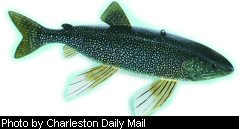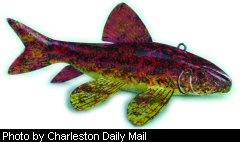Fish Decoys:
An Art of Deception
By Scott Morrison
 Most everyone is familiar with beautifully handcrafted duck decoys, carved and painted by skilled artisans. In several northern states, a less well-known but no less skilled guild of artisans craft fish decoys. Like their duck counterparts, fish decoys are used to attract prey within range for sportsmen. Fish decoys are one of the finest and oldest forms of American Folk Art. The history of fish decoys dates back hundreds, if not thousands of years. Eskimos and other Native Americans are known to have used them to lure fish under frozen lakes and streams. Europeans who settled in the colder portions of North America quickly learned to use fish decoys to attract fish that could be speared during the winter. Most everyone is familiar with beautifully handcrafted duck decoys, carved and painted by skilled artisans. In several northern states, a less well-known but no less skilled guild of artisans craft fish decoys. Like their duck counterparts, fish decoys are used to attract prey within range for sportsmen. Fish decoys are one of the finest and oldest forms of American Folk Art. The history of fish decoys dates back hundreds, if not thousands of years. Eskimos and other Native Americans are known to have used them to lure fish under frozen lakes and streams. Europeans who settled in the colder portions of North America quickly learned to use fish decoys to attract fish that could be speared during the winter.
Unlike fishing lures, fish decoys generally do not have hooks. Fish decoys are made to “swim” in a circle with just a light jerk on a “jig-stick.” Jig-sticks are similar to fishing poles but are much shorter and generally don't require a reel. They hold the line that is attached to the decoy.
Anglers using fish decoys sit in small shacks or tents that are placed over large holes cut in the ice. These shacks are known as “dark houses” because they have no windows. The only light coming into them is through the hole in the ice over which they are placed. This allows the spear fisherman to see into the water. Fish, however, cannot see into the dark hole above them. The jig-stick is worked with one hand, while the other hand is positioned near a large multi-pronged spear that can be thrown at fish attracted to the decoy. Darkhouse fishing can be practiced in six northern states: Alaska, Michigan, Minnesota, Montana, North Dakota and Wisconsin.
 Fish decoys are not made to imitate fish but are carved to manipulate fish. In other words, a good fish decoy doesn't need to look exactly like any prey item. The most important function of a fish decoy is to attract or manipulate fish within range of the spear. Fish are curious animals and can be attracted by colors, shapes or sizes they normally don't see. Realistically painted decoys are used to interest hungry fish, while decoys painted with folk art patterns can be used to attract curious fish. Another crucial feature for a fish decoy is for it to work, or swim, with as little effort as possible. The fins on a fish decoy are generally designed large, similar to the wings of a glider plane, to allow the decoy to glide longer. Fish decoys are not made to imitate fish but are carved to manipulate fish. In other words, a good fish decoy doesn't need to look exactly like any prey item. The most important function of a fish decoy is to attract or manipulate fish within range of the spear. Fish are curious animals and can be attracted by colors, shapes or sizes they normally don't see. Realistically painted decoys are used to interest hungry fish, while decoys painted with folk art patterns can be used to attract curious fish. Another crucial feature for a fish decoy is for it to work, or swim, with as little effort as possible. The fins on a fish decoy are generally designed large, similar to the wings of a glider plane, to allow the decoy to glide longer.
I started carving fish decoys out of basswood about four years ago, when it became obvious that I did not need any more duck hunting decoys. My decoys are completely handmade, using sharp knives and chisels. After the fish is carved and sanded, glass eyes are added, and then fins that have been cut from thin sheets of brass or copper are inserted into the decoy. At this point, the decoy is sealed, and lead shot is added into cavities that have been strategically placed in the bottom of the decoy.
 The decoy should “swim” forward when the jig-stick is lifted, and move forward again when it is dropped. I sometimes spend as much time balancing and swim testing the decoy as I spend carving or painting the fish. A good fish decoy should swim in at least a half circle with just one small tug of the jig-stick. Once the decoy swims to my satisfaction, I hand paint it with light washes of acrylic paints. After the fish decoy has dried, it receives a waterproof finish. The decoy should “swim” forward when the jig-stick is lifted, and move forward again when it is dropped. I sometimes spend as much time balancing and swim testing the decoy as I spend carving or painting the fish. A good fish decoy should swim in at least a half circle with just one small tug of the jig-stick. Once the decoy swims to my satisfaction, I hand paint it with light washes of acrylic paints. After the fish decoy has dried, it receives a waterproof finish.
Traditional fish decoy makers have added molten lead to their fish to make them sink. By using lead shot I am able to micro-adjust my decoys so they are just slightly heavier than water and swim forward slowly in a large lazy circle. This imitates a distressed fish that should be irresistible to any cruising predator.
Last February I had the opportunity to use my fish decoys on a trip to the Upper Peninsula of Michigan. Although I speared only one small northern pike in about two days of fishing, the experience was memorable. The morning of the last day, fish were attracted to the first six fish decoys I used. All of these fish were smaller than the legal minimum size, but it was fascinating to observe the reaction of the fish to my decoys. Small pike and musky would slowly come into my vision under the darkhouse and stay motionless inches away from the decoy. Some of these fish would stay near the decoy for several minutes before swimming away, and several actually struck the side of the decoys.
 The last fish I encountered during this trip was a northern pike about 18 to 20 inches long, below the legal minimum size of 24 inches for northerns in Michigan. This fish was attracted to a naturally painted musky decoy that was about seven inches long. The pike swam slowly towards the decoy, coming within about two inches of the lure. He then moved to the shallow bottom of the lake, and watched as I swam three other realistic decoys over him. The last decoy I tried was a simple five-inch white decoy with a red head. This folk art decoy brought him up from the bottom, where he watched the decoy make three circles just in front of his mouth. On the fourth pass he attacked the decoy, then swam off hungry, wondering about those “finned fakes.” The last fish I encountered during this trip was a northern pike about 18 to 20 inches long, below the legal minimum size of 24 inches for northerns in Michigan. This fish was attracted to a naturally painted musky decoy that was about seven inches long. The pike swam slowly towards the decoy, coming within about two inches of the lure. He then moved to the shallow bottom of the lake, and watched as I swam three other realistic decoys over him. The last decoy I tried was a simple five-inch white decoy with a red head. This folk art decoy brought him up from the bottom, where he watched the decoy make three circles just in front of his mouth. On the fourth pass he attacked the decoy, then swam off hungry, wondering about those “finned fakes.”
This incident has made me contemplate conventional fishing techniques and how many fish we unknowingly encounter while fishing in the Mountain State.
Scott Morrison is the district fisheries biologist in Parkersburg . |



